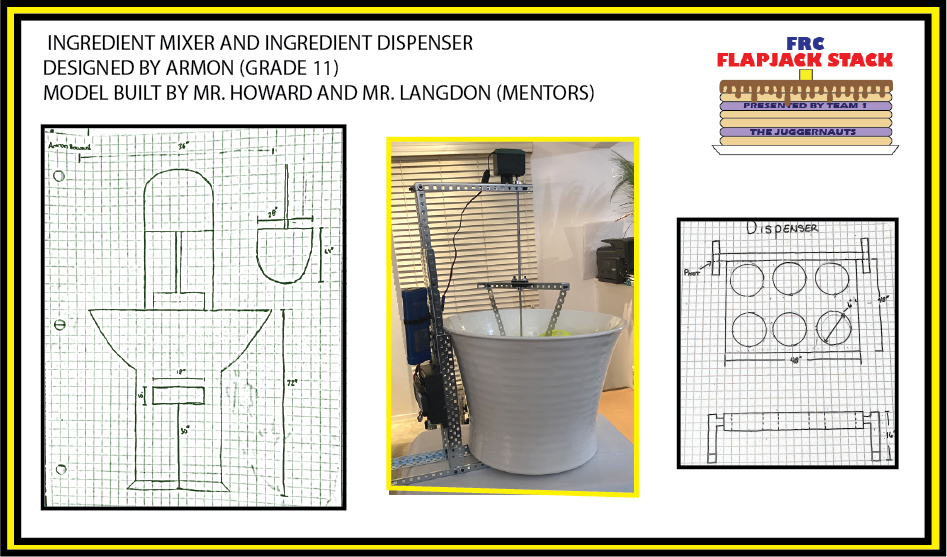2021 Game Design Challenge
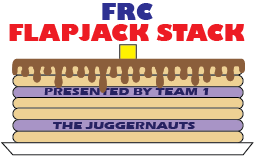
Game Field
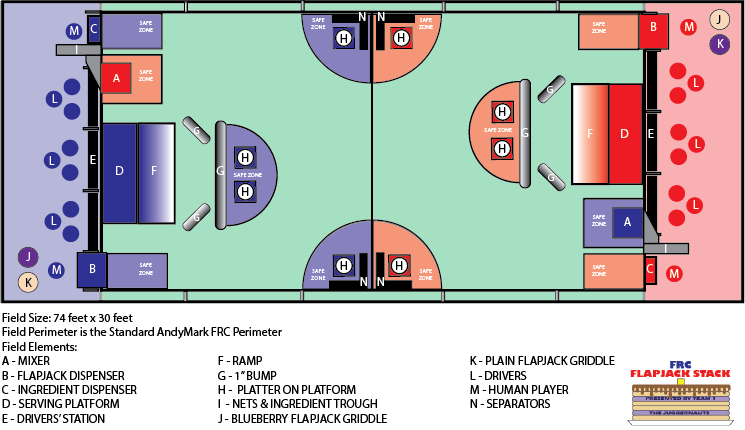
Game Overview
The game “FLAPJACK STACK” has a culinary theme. It involves two 3-team alliances, one red and one blue, competing to make, stack, and serve FLAPJACKS. Each match begins with 15 seconds of autonomous robot play called “AUTON,” followed by 2 minutes of “TELEOP” play where robots are driver-controlled. The final 30 seconds of TELEOP play is the END GAME where FLAPJACKS can be served up to earn bonus points. FLAPJACKS are made by putting INGREDIENTS into a large MIXER. The INGREDIENTS are in 8 inch, spherical packets, and earn 1 point when scored. The MIXER will turn on once five INGREDIENTS have been put into a MIXER. Only when the MIXER is turned on, will FLAPJACKS be “cooked” and made available from a fully automated GRIDDLE machine. Robots start each match with 6 preloaded INGREDIENTS and may acquire additional INGREDIENTS during a match from an INGREDIENT DISPENSER which is activated by the pull of a CHAIN. Once the MIXER has been turned on, HUMAN PLAYERS can dispense FLAPJACKS, one at a time, to the robots using a FLAPJACK DISPENSER. PLAIN FLAPJACKS are constantly available for dispensing from the PLAIN FLAPJACK GRIDDLE. A BLUEBERRY FLAPJACK, however, is only made available each time ten INGREDIENTS are scored into the UPPER MIXER opening. When this happens, it activates the fully-automated BLUEBERRY FLAPJACK GRIDDLE, which allows one BLUEBERRY FLAPJACK to be retrieved. HUMAN PLAYERS working in the COOKING AREA of the kitchen remove cooked FLAPJACKS from the GRIDDLES and place them into the WARMING CHUTE of their alliance’s FLAPJACK DISPENSER. Robots transport one FLAPJACK at a time to PLATTERS on one of their alliance’s PREP TABLES which are located in the NEUTRAL STACKING AREA of the field. Robots may stack as many FLAPJACKS (5 points for PLAIN, 10 points for BLUEBERRY) onto a PLATTER as they want but, if stacks fall over and FLAPJACKS land on the floor, they are contaminated and cannot be used again to score points. (there is no “5-second” rule in this kitchen!) The END GAME period is the last 30 seconds of the match. During the END GAME, special rules govern how robots may transport PLATTERS stacked with FLAPJACKS to their SERVING AREA. FLAPJACKS must be solely supported by the PLATTERS during the END GAME. Five points are awarded for each FLAPJACK and 10 points are awarded for each robot that are in the SERVING AREA at the end of the match. Combining the points earned from the END GAME, TELEOP, and AUTON periods provides each alliance’s total score and determines the winner of the match. For seeding purposes, teams get ranking points from the qualifying matches. Each match win earns 2 ranking points (RPs), a tie earns 1 RP, scoring enough INGREDIENTS to turn on the MIXER in AUTON earns 1 RP and, at the end of the match, an alliance with 2 robots on their SERVING PLATFORM while each holds at least one PLATTERED FLAPJACK earns an END GAME bonus of 1 RP.
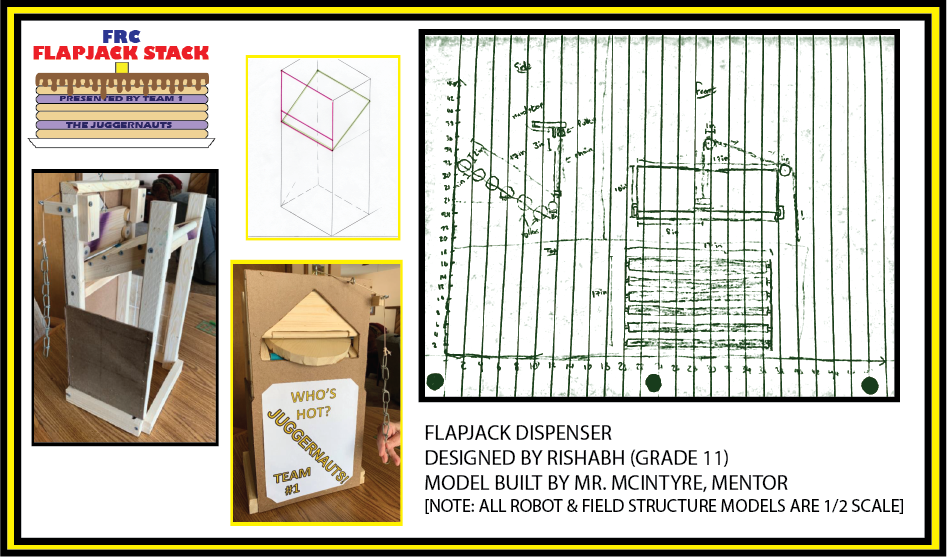
Description of notable field elements
Each alliance has a MIXER in their COOKING AREA. The BOWL of the mixer has a 3’ diameter and a height of 6’. There is a lower scoring option called the CHUTE which is 30” from the carpet. The CHUTE is 18’ wide and 10” tall. A series of nets are installed behind the MIXER to redirect missed INGREDIENTS to human players (HPs). It has a PADDLE with a width of 28”, a height of 77”, and a blade height of 64”. Placing five INGREDIENTS anywhere in the MIXER activates the PADDLE and the MIXER is considered “turned on”. A GRIDDLE for dispensing BLUEBERRY FLAPJACKS to HPs is controlled by a signal from the MIXER, which uses a servo motor to open a door on the GRIDDLE, each time 10 INGREDIENTS are scored in the BOWL. The FLAPJACK DISPENSER is located in the COOKING AREA. HPs place one FLAPJACK (a flat disk, 15” by 1.5” thick) at a time onto a 30-degree sloped WARMING CHUTE. From the top of the DISPENSER down to the CHUTE is a pull-CHAIN that raises a gate. This allows a FLAPJACK to enter the field through a DISPENSER opening two feet above the floor. The SERVING AREA consists of a RAMP and a PLATFORM. The SERVING AREA PLATFORM is 4’ x 12’ x9’’ high and is connected to a 18-24’’ ramp along the field facing side. The ramp is sloped at a 24.6 degree angle which will cause drivers to think about their robot’s abilities. In the middle of the field, each alliance has four 20” x 20” x 24” high PEDESTALS where the FLAPJACKS are stacked. On each of these PEDESTALS, rests the PLATTER. FLAPJACKS are stacked on top of these. The PLATTER has handles on each side for robots to hold.

Description of expected robot actions
At the beginning of the match, robots will try to shoot their preloaded INGREDIENTS into the MIXER in order to start it and get the 10 point AUTON bonus. During the TELEOP period, robots will have to drive across the field to acquire more INGREDIENTS from their Human Player. They will race back and try to score them in the MIXER. Some robots will opt for the easier task of scoring them in the LOWER CHUTE, while other will try to score them in the UPPER BOWL. Teams will have to decide if they want the extra points for stacking BLUEBERRY FLAPJACKS (10 points) or stick with PLAIN FLAPJACKS (5 point). Robots will also have to acquire the FLAPJACKS from the FLAPJACK DISPENSER. This means that they will have to design a mechanism for pulling the CHAIN to release the FLAPJACK into their possession. Robots may try to grab the FLAPJACK or store it until it is time to stack it. Robots may only possess one FLAPJACK at a time. Robots will then drive to the STACKING AREA to stack the FLAPJACK. They will have to design a mechanism that will stack at varying heights, because the top of the stack will change with each added pancake. Strategy will come into play as alliances decide how high of a stack they think they can control and how many robots have the ability to move the stacks. Robots will continue this cycle, creating higher and higher stacks of FLAPJACKS. During the END GAME, robots will grab one of the PLATTERS and attempt to move it over the bumps, up the ramp and onto the SERVING AREA PLATFORM. Robots will have to be careful to maintain the stability and angle of the PLATTER to keep the FLAPJACKS from falling over.
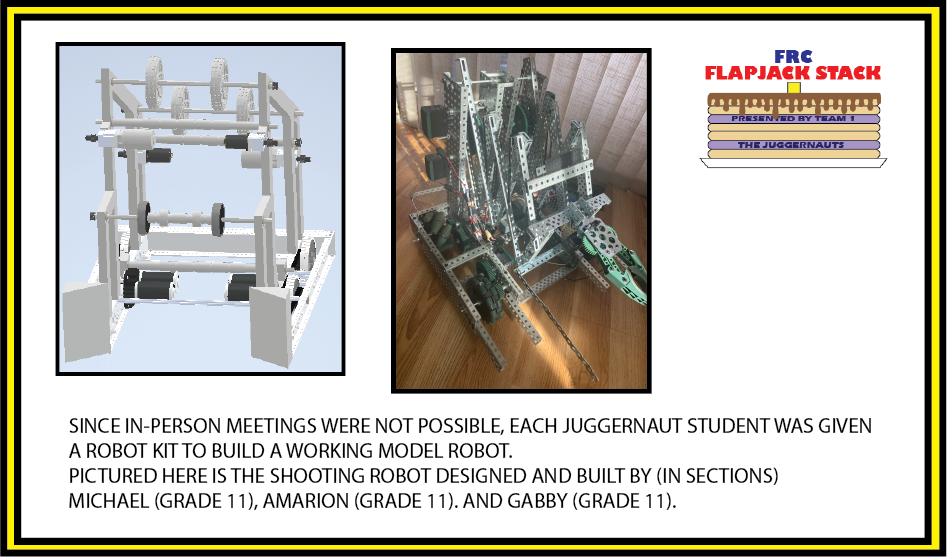
How the Element is used
FLAPJACKS are dispensed from the HP to the robot using the FLAPJACK DISPENSER. The FLAPJACKS are put into a sloped CHUTE that allows them to fall into or be grabbed by the waiting robot. However, the FLAPJACK DISPENSER has a gate on the front that keeps the FLAPJACKS from simply falling out onto the floor and be rendered unsuitable for consumption. Therefore, robots must open the gate of the FLAPJACK DISPENSER in order to release the FLAPJACK. To do this they must pull on a CHAIN that is attached to a pulley system that raises the door the necessary few inches to allow the FLAPJACK to slide out. Also, the INGREDIENT DISPENSER is designed so that the HUMAN PLAYER loads six spherical INGREDIENTS into a tray in the DISPENSER at one time. The robots acquire the INGREDIENTS by pulling a CHAIN which causes the tray of INGREDIENTS to tilt downwards and gravity takes over. When the robot releases the CHAIN, the INGREDIENT tray returns to the loading position. In order to use either of these items, teams must build a robot that is capable of pulling a CHAIN in a vertical direction for several inches and then release the CHAIN.
